AMERICA is full of iconic roads. Highway 61, Route 66. Stretches of tarmac some rambling troubadour should get round to writing a song about. Oh, they already have? Well let me hymn an unsung hero among highways – the remarkable Natchez Trace Parkway.
Against an immense sunset we chewed over the highway life and America’s lost innocence
It runs north from cotton barons’ river base Natchez to country music capital Nashville, skirting the likes of Jackson and Elvis birthplace Tupelo, but also taking in a wealth of smaller settlements and Civil War sites. As part of our Deep South road trip we drove its entire 444 mile length, through Mississippi, Alabama and Tennessee, branching off to Oxford, home town of literary heavyweight William Faulkner, and Memphis with its myriad musical monuments.
Time ruled out detours to the Delta (blues) and Muscle Shoals (soul), sources of the soundtrack to the South, but essential tracks (Pickett, Franklin, Lead Belly, Allman Brothers) boomed from our hire car stereo.
The Parkway is essentially an unspoiled strip of National Park, where all commercial activity – road signs, neon-lit diners, trucks – is barred and a 50mph speed limit is enforced on the two-lane road. Access is limited to just 50 intersections. All historical sites, camping grounds and comfort stops are discreetly signposted. Venture down side roads to time warp townships such as Port Gibson or the awesome Windsor ruins, a plantation house accidentally burned down in 1890. Or just find a clearing for a picnic.
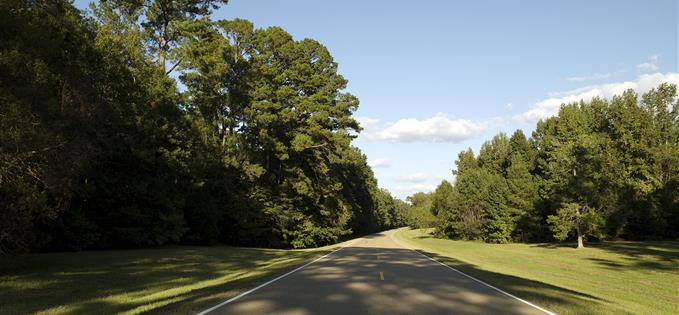 Natchez Trace Parkway; below, Windsor Ruins
Natchez Trace Parkway; below, Windsor Ruins
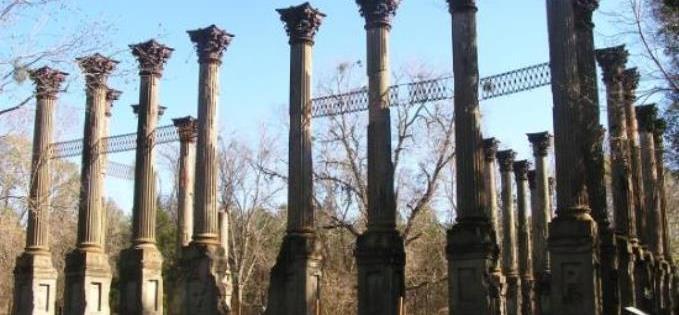
The varied scenery is exceptional. Forest often hems you in (there are over 100 different trees in the park from dogwood to redbud – Fall must be wondrous), so it’s easy to lapse into miles of hypnotic green reverie. As the late great Grateful Dead sang (with a certain chemical undertow): “What a long strange trip it’s been.”
Today’s Parkway follows the ancient animal track called the Natchez Trace, parts of which are preserved, used by Native Americans for centuries, then by settlers. Traders from the north, who brought goods downstream to Natchez would traditionally sell the raft and trudge back home up the Trace. Riverboat steamers eventually killed off the trade and the path.
 Natchez is packed with historic houses
Natchez is packed with historic housesSnooty Natchez on its bluff 200ft above the Mississippi makes a lovely place to wander (or take a horse-drawn carriage) with much of the lay-out unchanged from when the Spanish established a new town here in the 1790s. Spared major Civil War damage, it is home to more than 600 antebellum buildings – amazing for a town of just 15,000 inhabitants.
 Inside Longwood, below
Inside Longwood, below

Among those you can visit I’d recommend Stanton Hall, a Greek Revival mansion built for a cotton magnate in 1857 and, more impressive still, Longwood, the largest octagonal house in America. Work on wealthy planter Haller Nutt’s dream mansion was halted by the Civil War in 1861, when the craftsmen fled back to Philadelphia, and was never resumed. The family lived on in the basement below the amazing shell. The easiest way to book to se such houses is via Natchez Pilgrimage Tours.
You can’t leave town without going down to the riverfront Natchez Under The Hill, described in 1810 as “for its size in the whole world there is not a more dissipated spot.” The whores and river pirates are long gone (the gamblers remain), but the Mississippi still keeps rolling along. The historic Saloon was heaving, so we sat on the verandah of a lovely craft beer bar called The Camp. Against an immense sunset we chewed over the highway life and America’s lost innocence with a Florida coastguard on his own Harley Davidson road trip. From New Orleans to Atlanta our trip was littered with such enlightening encounters.
 Beale Street is a blues theme park
Beale Street is a blues theme parkAfter sleepy Natchez Memphis was quite a culture shock. The city sprawl is ugly and edgy before you reach Downtown, the best place to base yourself with the river a couple of blocks away and major attractions such as Beale Street, Sun Studio, the Memphis Rock ‘n’ Soul Museum and the National Civil Rights Museum within easy reach. Stax and Graceland are further out.
Every night is party night along Beale Street, hence the huge police presence. Blues pounded out from every doorway as we made the obligatory crawl from the late BB King’s iconic bar to where Beale peters out at the modest wooden home of WC Handy, whose 1912 trailblazer, ‘Memphis Blues’ earned him the sobriquet ‘Father of Blues’. It’s now a museum.
Only bits of Beale were saved from the bulldozer in the Sixties and what remains has a tarted-up corporate ‘good times’ vibe to it, lacking the frenetic loucheness of New Orleans equivalent Bourbon Street. As a huge storm rolled in from across the Mississippi we sought refuge a few blocks away at the Flying Saucer Draught Emporium and worked our way through its vast craft beer selection while watching fans of the victorious Memphis Grizzlies basketball team streaming home, including one diehard in a saturated bear suit.
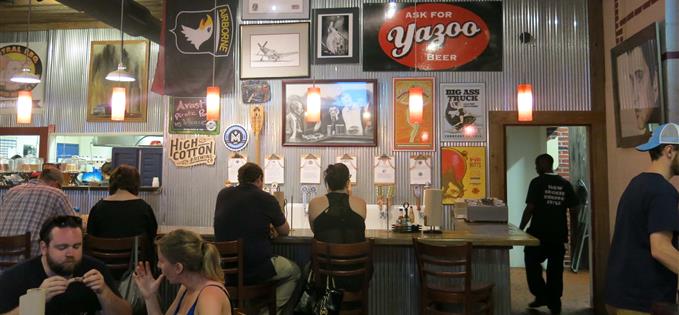 Central Barbecue, Memphis
Central Barbecue, MemphisClose to the legendary Peabody Hotel (where each day at 11am resident ducks are marched down from their rooftop coop to the lobby fountain, returning at 5pm), the Saucer became a regular haunt during our Memphis stay. As did the Downtown branch of Central Barbecue. This barnlike place to sample ribs, smoked brisket and pulled pork is conveniently next to one of the world’s great museums – the National Civil Rights Museum at the Lorraine Motel.
 Fatal balcony at the Lorraine Motel; part of the Civil Rights Museum , below
Fatal balcony at the Lorraine Motel; part of the Civil Rights Museum , below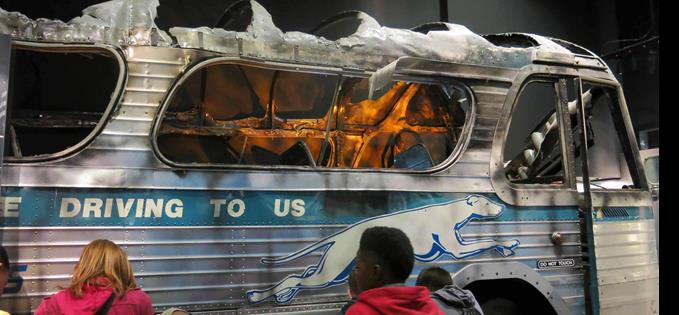

The Lorraine Motel is where Martin Luther King was fatally shot on the balcony of his second floor room on April 4, 1968. A huge museum complex is now attached, the carefully preserved bedroom the culmination of your tour, which offers remarkable insights into the black American experience from slavery to the Civil Rights struggle of the Sixties led by the charismatic preacher.
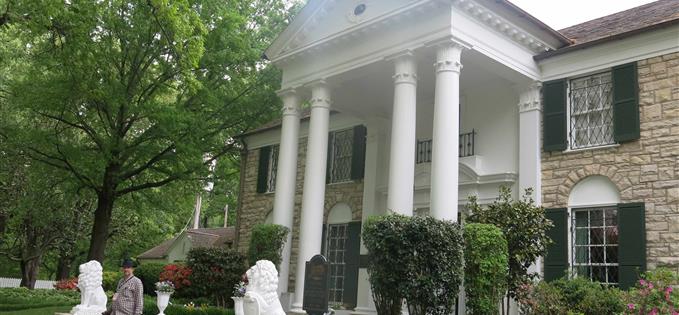 Graceland, over-the-top home of the King
Graceland, over-the-top home of the KingGraceland is a monument to an equally charismatic Southerner. Elvis Presley is buried in the 14 acre grounds of his surprisingly modest mansion, which is a shrine both to him and his nouveau riche Sixties decor sense, which starts with chandeliers, gold-on-white trim and swagged draperies in the formal rooms and descends to the tacky bravado of the Jungle Room and his dens. I found it strangely homely and touching, but then I was a fan of the Beverley Hillbillies. We skipped his car collection at the visitor centre and the jet named after his daughter Lisa Marie (who still uses Graceland’s top floor, which is closed to the public). See my Graceland gallery at the end of this piece.
This over-the-top experience is a far cry from his birthplace in Tupelo, Mississippi, a shotgun shack, convenient from the Natchez Trace Parkway. We dropped by on the way to Nashville, but found an absence of substance.

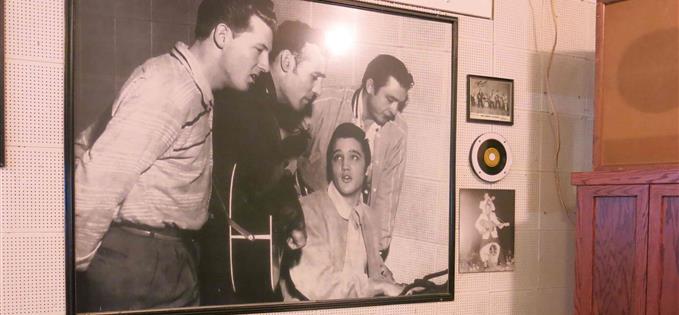 Elvis and friends on the studio wall
Elvis and friends on the studio wallThat couldn’t be said of Memphis’s other Elvis mecca, Sun Studio, where Presley, Jerry Lee Lewis, Johnny Cash, Royal Orbison and Carl ‘Blue Suede Shoes’ Perkins all cut records that redefined popular music in the Fifties. If that sounds a bit pompous, the jolly studio tour isn’t.
Jolly was the word too for the Rajun Cajun’ Crawfish Festival, which brought the locals en masse down to the riverside on a Sunday afternoon to wolf buckets of the crustacean critters dowsed in hot sauce and listen to genial bands rock out. It was perfect end to an amazing city stay.
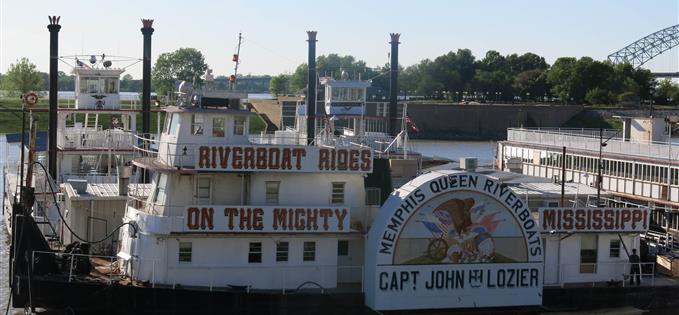 Riverboat docked at Memphis, near the crawfish festival
Riverboat docked at Memphis, near the crawfish festival

Quite a contrast again at our next port of call – Oxford, 80 miles to the south. Built on Chickasaw Indian land, it was given the name in the hope it would one day become a college town, which it duly did in 1848, when the University of Mississippi was set up. These days it is the very model of a uni town – with Square Books, one of the best bookshops in the States, a great craft beer bar and eclectic music venues. and a clutch of fine restaurants, most owned by one chef John Currence, whose gourmet City Grocery and folksier Big Bad Breakfast cabin were both excellent.
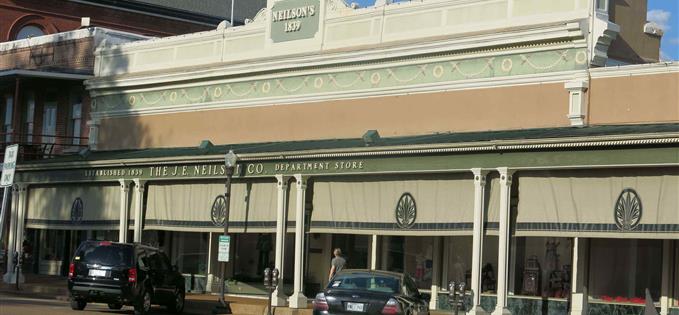 Retro look store in Oxford's Square
Retro look store in Oxford's SquareSo far, so laid-back, but in the past Oxford has known its share of turmoil. Much of the town was razed during the Civil War and in 1962 it was the epicentre of Civil Rights conflict, when James Meredith enrolled at the University as its first African American student – to put pressure on the government to dismantle educational segregation. During ensuing violence Meredith was shot by a white gunman on a march.
 Our Oxford guide, Jack, at Rowan Oak, Faulkner's house
Our Oxford guide, Jack, at Rowan Oak, Faulkner's house

Our guide to town and campus, local historian Jack Mayfield, lived through the Meredith mayhem and is steeped in the tangled history of the South. He accompanied us to a place of literary pilgrimage, Rowan Oak, home of Nobel prizewinning novelist, William Faulkner.
Oxford and Lafayette County inspired the fictional landscape of Yoknapatawpha County, backdrop to The Sound and the Fury, Absalom! Absalom! and AsI Lay Dying – groundbreaking novels both in dark subject matter and narrative experimentation.
Some literary shrines offer no sense of the writer or his work, but Rowan Oak is suffused with the eccentric, curmudgeonly presence of Faulkner, reclusive social misfit, womaniser and alcoholic (even today fans leave miniature spirits bottles by his grave).

If literature still dominates Oxford life, music isn’t absent. It’s home to Fat Possum Records, champions of the Hill Country Blues, less languid, more rhythmic than its Delta counterpart in the hands of Junior Kimbrough, RL Burnside and the North Mississippi Allstars (pictured).
Time to hit the Parkway again at Tupelo. We stuck the All Stars on the stereo, to rough up the ‘green, hypnotic reverie’. Next stop Nashville... ah well, that’s a whole new musical story.
Read about the rest of of Neil’s Deep South road trip – New Orleans and Cajun Country.
Fact file
Getting there
Neil Sowerby flew direct from Manchester to Atlanta with Virgin Atlantic, which runs a daily service. He flew on from Atlanta to New Orleans with Delta to start his road trip.
Getting around
Neil hired a car from Alamo at New Orleans Airport and returned it at Atlanta Aiport before flying back to the UK. Alamo has car hire branches throughout the USA. All-inclusive rates are available via www.Alamo.co.uk/USA
Staying there
Natchez Grand, 111 Broadway Street, Natchez, MS 39120.
Sleep Inn at Court Square, 40 N Front St, Memphis, TN, US, 38103.
Hampton Inn-Conference Center, 103 Ed Perry Blvd, Oxford, Mississippi 38655.
Visit the Natchez Trace Parkway site for full information.
For your essential guide to Natchez visit this link.
For full information on Memphis visit the Memphis Convention and Visitor Bureau site.
For your essential guide to Oxford visit this link.
Individual online guides to Mississippi and Tennessee: www.visitmississippi.org
and http://www.tnvacation.com.
Visit DiscoverAmerica.com to start your own USA adventure.
Neil Sowerby parked at Manchester Airport. For full details of parking there visit this link.
Graceland – a gallery













